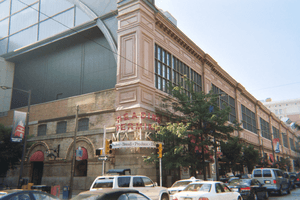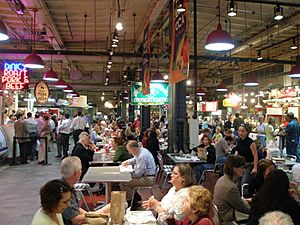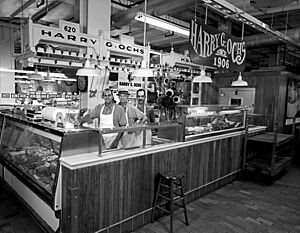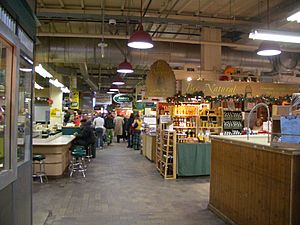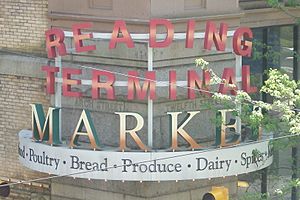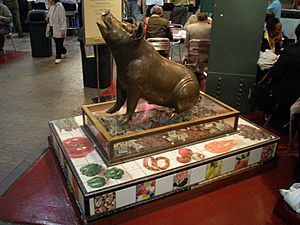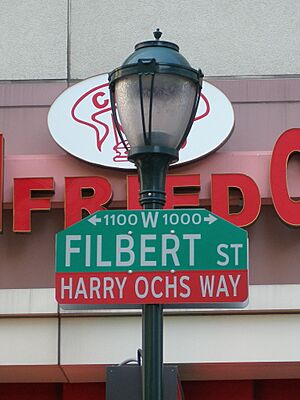Reading Terminal Market facts for kids
The Reading Terminal Market is a famous indoor public market in Philadelphia, Pennsylvania. It's located at 12th and Arch Streets in the heart of the city. The market first opened in 1893. It was built under the elevated train tracks of the Reading Railroad Company. The city wanted to move outdoor street markets indoors for safety and cleanliness.
Today, the market is still on the ground floor and basement of the old train shed. This area is now part of the Pennsylvania Convention Center. Over 100 different shops and food stalls fill the market. You can find fresh fruits, vegetables, meats, fish, cheeses, and delicious baked goods. There are also crafts, books, clothing, and many kinds of specialty and international foods. Two of the shops are even run by families whose ancestors were original merchants from the 1800s!
The market's basement has a special refrigerated storage area for the vendors. The market is open every day. However, the Pennsylvania Dutch merchants, who are a small but important group, usually close from Sunday to Tuesday.
Market History
How It Started
For a long time, Philadelphia had open-air markets. These markets stretched for a mile along what is now Market Street. But as the city grew, people started to think these outdoor markets were dirty. They also caused a lot of traffic and noise.
So, in 1859, city leaders decided to close all the outdoor markets. Instead, they encouraged indoor markets. Two indoor markets, Franklin Market and Farmers' Market, opened at 12th and Market Streets. These two markets were the beginning of what would become the Reading Terminal Market.
Growing Bigger
During the Industrial Revolution, railroads became very important. Big, fancy train stations were built in major cities. The Reading Railroad built its main train station, called the Reading Terminal, in 1893. This station was designed by F. H. Kimbal. The train tracks were raised up, and the new market was built right underneath the train shed. The market actually opened a year before the train station, in 1892.
A very cool part of the market was its advanced refrigerated storage area in the basement. It opened in July 1893. This huge area had 52 separate rooms. Each room could be set to a different temperature. This meant merchants could keep meat, poultry, fruits, and vegetables fresh all year round! Before this, many products were only available when they were in season. This special storage was expensive to run, but it was worth it. Other businesses, like restaurants and even hospitals, also rented space there to store their goods.
In its first few decades, the Reading Terminal Market was a huge success. It had 380 merchants in its first year. For the next 60 years, it was almost always full of busy shops. The market even offered a special service. People living in the suburbs could order groceries, and the market would deliver them to their nearest train station! Later, refrigerated trucks helped the market reach even more towns.
Tough Times
The Great Depression in the 1930s made things difficult for many businesses, including the market. Also, new supermarkets started opening. One even opened right across the street, competing directly with the market. This meant fewer farmers sold their goods directly. Instead, more "middlemen" bought goods from others and resold them.
Even with these challenges, the Reading Terminal Market managed to stay open. Some people even said it did quite well! In the 1930s, the market was shipping phone orders to 38 states, Canada, and Mexico. To help promote the market, the Reading Terminal Market Merchants Association was formed in 1930. They organized events like food shows and helped pay for new lights and decorations.
World War II in the 1940s actually helped the market. Because of food shortages during the war, demand for the market's goods increased. In 1944, the market was almost completely full. On May 9, 1946, over 12,000 people came to the market. They wanted to buy meat and other products that were hard to find elsewhere.
However, the 1950s and 1960s brought new problems. More people moved to the suburbs, and fewer people used trains. The market started losing money in 1954. By 1959, only 70% of its spaces were filled. The amazing cold storage facility in the basement was even shut down. The Reading Railroad Company, which owned the market, went bankrupt in 1971. They stopped focusing on the market and looked for ways to sell the building.
A New Beginning
In the 1980s, the Reading Company decided to try and save the market. These efforts continued even after the trains moved to a new underground station in 1984. In 1990, the market's ownership went to the Pennsylvania Convention Center Authority. Then, in 1994, a new non-profit group called the Reading Terminal Market Corporation (RTMC) was created to run the market.
Both groups worked hard to bring the market back to life. They found new shops and promoted the market more. By the mid-1990s and 2000s, the market was thriving again. Over 90% of its spaces were filled with successful businesses.
Today, the market is a popular spot for both locals and tourists. People come to buy fresh food, unique treats, and special items. It's listed as a must-see place in Philadelphia, just like Independence Hall and the Liberty Bell. The market is also close to many hotels, the Convention Center, and a shopping mall.
The market's main goals are:
- To keep the market looking and working like an old-fashioned urban farmers' market.
- To offer a wide variety of fresh and prepared foods from farmers, growers, and chefs.
- To be a welcoming place that celebrates different cultures and helps people connect.
- To keep the important connection between city and country communities.
- To make sure the market stays financially strong and can support itself.
These goals show how the market community works together. They are a non-profit organization that provides great service.
The market continues to change and grow. While it still has long-time shops like Bassett’s Ice Cream (which has been there since 1893!), it also adds new and exciting vendors. You can find unique food carts, a winery, and even a beer hall. Some day-carts, which used to sell souvenirs, now offer food and drinks. One of the newest vendors is a local craft distiller.
The market also hosts many fun events. These include beer tastings, cultural food series, and community gatherings. For example, they've held events to help Syrian refugees get to know their new neighborhood.
Philbert the pig is the market's mascot. He's a sculpture by artist Eric Berg. Any money donated to Philbert helps support healthy eating programs run by The Food Trust.
The Reading Terminal Market has even been a filming location for movies like Trading Places and National Treasure. Some of its food stalls have been featured on TV shows too. For example, Tommy DiNic's Beef and Pork was on the Travel Channel's Man v. Food. Mueller Chocolate Co. was featured on Food Network's "Guilty Pleasures" and Andrew Zimmern's "Bizarre Foods."
Images for kids


